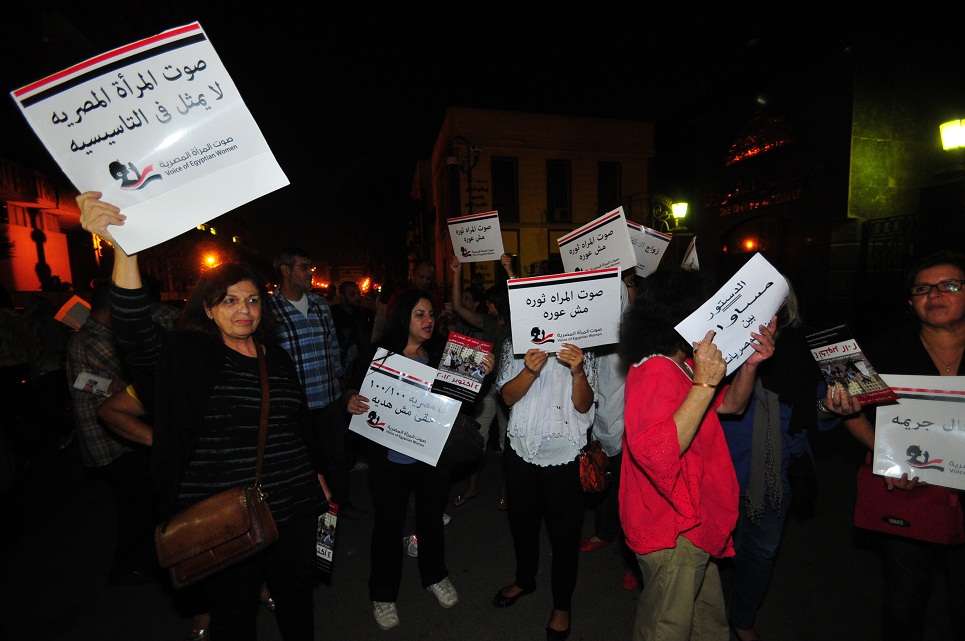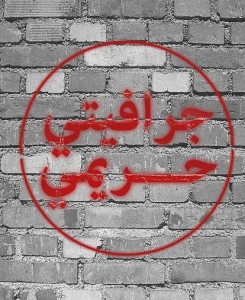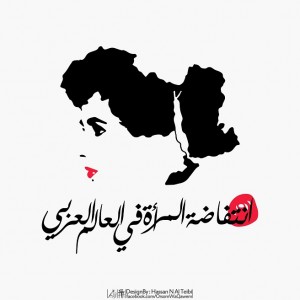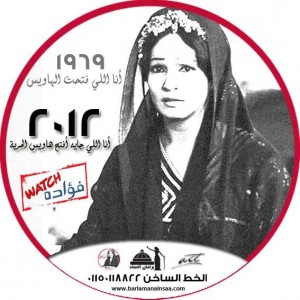“I’ve opened the floodgates.”
This is the slogan that appears next to the proud face of the famous Egyptian actress, Shadia, covering the walls of buildings around Cairo. It might be meaningless to foreigners, but to Egyptians, Fouada is a character engraved in popular memory. She was the heroine of the Egyptian classic film she’ men el khouf, something of fear, where a despot, Atris, punished the inhabitants of a village by closing off access to the river, leaving them and their plants to die.
Fouada was the only one brave enough in the village to open the lock, allowing water to flow and drench the dry land. She was a symbol for Egypt; Atris was a symbol for dictatorship. Ever since, Fouada has been a symbol of freedom and bravery. She has now been resurrected by post-revolutionary women’s groups. A nod to Egyptian women’s activism of the past, Fouada’s face decorating the streets of Cairo, pushes the debate about women into the public sphere.
Post revolutionary Egypt is one of political dynamism and cultural activism. Before the revolution, Egypt’s barely had 24 political parties, but after 25 January the number rose to 62, according to the Political Parties Affairs Committee.
A similar increase happened in the number of civil society organisations (CSOs), which reached 36,000, compared to 34,000 CSOs before the revolution, according to Abdel Aziz Hegazy, head of the General Union for Civil Society Associations and Foundations. Women’s pressure groups and organisations were no exception. Initiatives continue to spring up.
The history of women’s political participation and activism in Egypt goes back to the early 1900s. Women in Egypt have been active whether through pressure groups and non-governmental organisations, or organically within their local communities in jam’iyyat (associations).
Women’s organisations and NGOs have achieved much under the Mubarak regime. From lobbying to amend legal codes such as the Personal Status Law, spreading awareness on women’s rights, pushing for women’s political participation, or fighting women’s issues such as domestic violence and female genital mutilation (FGM).
After the revolution, whether through organisations or on their own, women continue to make gains in these areas. Initiatives such as “the parliament of women” sought to train women running for parliament on how to campaign and how to submit proposals to parliament.
However, the “NGOisation” of women’s rights work has been criticised for its alienation from women in local communities, because it does not identify with their problems, but rather restricts its scope to certain issues.At the “Activism and the Academy” conference in New York 2011, Dr Rabab El Mahdy, a political science professor at the American University in Cairo and an activist, problematised the question of women’s rights after the revolution saying “most women’s rights NGOs have defined a limited agenda of their own that prioritises a certain identity for women; one based solely on their gender as opposed to their class or location or even their most pressing concerns.” In reaction to this, women’s NGOs are now adapting a more grassroots approach.
Women’s words from the revolution
“During the revolution and right after it, the depictions in international media were always focused on men. Men were protesting and photographed and little attention was given to women,” said Leil-Zahra Mortada, the director of Words of Women from the Egyptian Revolution (WWER).
Mortada was irritated by that stereotypical assumption about Egypt and the Arab world in general. This irritation triggered an idea in his head. “So I started out a photo album on Facebook featuring only women in the 18 days [of the uprising] to show they existed, to acknowledge their contributions,” he said. Afterwards, the album went viral on the internet.
“However, with the photo album people sometimes focused on the beauty of the woman and not her contributions and the story behind her picture.
“This is when the second trigger flashed in my head. It was about capturing the stories behind the faces in the pictures. It was about the importance of preserving the oral history of the revolution,” said Mortada.

The WWER initiative aimed at focusing on women through video, taping interviews where they tell their stories and their experiences during the revolution. “History is going to write about celebrities and how they acted in the revolution and their impact on the masses, so we normally avoided those with a high media profile. Unless they did something exceptional, we preferred to focus on the other not so famous women whose stories were groundbreaking,” Mortada explained.
The initiative started by interviewing some of the woman activists who took part in demonstrations and marches all over Cairo. According to Mortada, these activists were initially hesitant declaring that their contributions have not been great and that there would be other people out there who had more significant and more worthy experiences to be shared. He said, “but the moment they sat and told their stories. They were inspirational.”
Mortada and WWER team took part in the revolution and they did not see this conflicting withtheir mission. On the contrary, they explicitly chose the revolution’s side and they wanted to record an oral history from within and not as an impartial or objective party. He said, “we lived the revolution and were part of it and that helped us in setting up the context for our videos.”
WWER started circulating on social media channels such as Facebook, Twitter and Youtube. However, the team was also approached by women who voluntarily wanted to talk about what happened with them and what they witnessed.
WWER, in collaboration with Mosireen, a non-profit media centre in Cairo providing a collective space for citizen journalism and cultural activism, created a media archive of the full interviews for people interested in research.
On final notes, Mortada said, “we wanted to extend the initiative outside the scopes of Cairo and Alexandria, but we could not afford the expenditures of the travelling, but after we hand over the initiative to a committed group, the makers try to have a brief tour of the Arab countries, especially those that experienced revolutions like Libya, Bahrain and Tunisia, with the aim of teaching people about Egypt’s experience in conserving oral history.”
This tour will result in special episodes from the Arab Countries.
Fouada Watch
After the revolution the principles of accountability and transparency were emphasised and carried more weight than before. So in an effort to hold the presidency accountable for violations of human rights, the Centre for Advanced Means for Development (ACT Egypt), launched an initiative known as Fouada Watch.
The initiative came to life after President Mohamed Morsy was elected. Fathy Farid coordinator for youth initiatives at ACT Egypt explained how Fouada started. “We thought we cannot deal with the presidency like we did before the revolution. We needed new means and methods to monitor legislative and executive authorities.”
The initiative aims to monitor the presidency through evaluating laws the administration and the cabinet pass. It receives complaints about violations experienced by women in Egypt. It follows strategies such as examining the press, TV and social networks. Farid said, “we check if the government is being transparent about the laws it issues, whether it is blocking information or refraining from responsibility.”
The newspapers Fouada monitors are diverse. Some are national, others are independent and the rest are party newspapers. They evaluate leading news for objectivity and the space that is given to news.
The initiative publishes reports almost every month and sends out the reports to NGOs, CSOs, political parties, media channels and most importantly, the presidency.
The initiative works on the ground through a network of 60 volunteers and has launched campaigns to fight sexual harassment in collaboration with other NGOs and feminist groups during Eid El Adha and Eid El Fitr (the biggest two holidays in the Muslim calendar).
The campaign was big and popular among young volunteers. It was called shoft taharosh, I saw harassment, and it aimed to empower women by informing them of the legal steps they can take to report harassment, by spreading awareness among harassers, and by documenting harassment to help the government combat it.
Like other women’s rights groups, Fouada rejects the current draft of the constitution due to its lack of support for women’s rights. Farid said, “through our campaign dostourkom batel batel, your constitution is void, we are currently mobilising public opinion to reject the constitution by disseminating stickers and posters.
These list controversial articles, such as Article 64 that says women rights can not to violate the rulings of Islamic Shari’a law and the lack of articles on banning torture, forced detention and trafficking. Other women’s groups and volunteers have adopted the campaign and are currently spreading it around Egypt, reaching governorates such as Qena.
Farid said, “NGOs, groups and active individuals in a few governorates invited us, while others haven’t heard about us yet, but that’s why we’re seeking to work on a grassroots level.”
When Fouada visits a governorate it sends out calls through social media so that volunteers who are interested can join. This helps to build up pockets of supporters, with that aim that in the future, these will grow to be “multiple pressure groups and a network throughout Egypt to support women’s rights.”
Nooneswa: Graffiti Harimi
With a different approach, Mirna Tames and Shady Khalil launched graffiti harimi, Women Graffiti, with the collaboration of the activist group, Nazra for Feminist Studies. The initiative seeks to exhibit the role of women in society. The graffiti draws on some of the cultural references that Egyptians are familiar with such as Souad Hosni, one of the most popular actresses in Egyptian cinema, and Om Kalthoum, the singer dubbed “the Star of the East”, and uses them to communicate different messages about the status of women.
Tames noticed how most of the graffiti on the walls of Cairo was reserved for men and thought about creating one strictly for women. Khalil, her colleague and a campaigner at Graffiti Harimi, said, “Mirna thought it was a silly idea in the beginning, but then we liked it and we started brainstorming about the messages we want to deliver with the help of Nazra.”

Graffiti Harimi Logo
He added, “we sought the help of young artists who are not famous so that we get the chance to encourage those who do not have enough experience to join. We started using famous cultural references such as Shadia with the message ‘the girl is like the boy’ in reference to women’s empowerment and equality and Om Kalthoum ‘give me my freedom release my hands’ in reference to freedom.”
Nooneswa held its first spraying campaign during the march to mark the first anniversary of Samira Ibrahim’s virginity test case on 9 March (Ibrahim was a victim of virginity tests carried out by the army under the reign of the Supreme Council of Armed Forces). The used the slogan “once a woman went out of her house, she got a virginity test.”
Ola Tawfik, the initiatives coordinator at Nazra believes graffiti is a good tool for awareness because the Egyptian street has grown to notice it and beaffected by it after the revolution. She said, “people are used to seeing it and it’s no longer peculiar sight. That’s why we should capitalise on that fact and contribute to the dynamism graffiti is creating, to make it in favour of women and their rights.”
Kahlil explained the goal of Graffiti Harimi saying, “we seek to break taboos and some of the constructs that society creates. It provides public space for women to invert negative social stereotypes and instead build positive images to honour the women of our society.”
“The initiative focused on areas far from Downtown Cairo, we headed to suburbs such as Misr El-Qadeema and Dar El Salam (congested neighbourhoods in Cairo).” Khalil said, “we deliberately go down to the streets at times when streets are crowded and people stop upon seeing us and they approach us and ask questions. Some fight with and curse at us, others discuss. So we’re happy to stir discussions. Even if they attack us, we give them something to think about.”
Also, the campaign travelled to Mahala City in Gharbeya governorate because it was one of the first cities in Cairo that were on strike. It also has a great number of women in the workforce. Khalil reflected on the initiatives’ experience there, he said, “we wanted to make sure that our designs were coherent with our messages and beliefs in the empowerment of women so we met with women who led protests back in 2006 such as Wedad El-Demardash and Amal Saeed and they inspired our message and designs.”
Graffiti Women has themes for their campaigns and their next campaign is expected to be about the body and how society objectifies women.
The uprising of Arab women
Shortly after the Arab spring swept the Middle East, in October 2011 four young women activists came together from Lebanon, Egypt and Palestine. They started a Facebook page called “the Uprising of Arab women.”
The young activists had a goal in mind, to create a platform for women to narrate their stories and to continue their quest to define what an “Arab woman” is.
Sally Zohney one of the administrators of the page from Egypt said, “we rhetorically use the word Arab woman, but we don’t really know what it means. Through the page we [the Arab women interacting] are discovering what Arab means for us and what identities it transcends.”
Zohney added, “we do not know about each other. A woman in Egypt doesn’t know about women in Yemen. So it’s a way to tell our stories and share them with each other. It’s to confirm our identity and culture.”

The uprising of Arab Women logo
The page depicts unspoken struggles that usually go unnoticed. Stories of Palestinian women dropping their children to school, or women in Egypt facing sexual harassment on a daily basis, are told in their own words. The page starts dialogue and discussion about issues such laws regarding rape, honour killing and nationality. It is expected that the founders of the page will start a blog for women to freely express themselves.
In October, on the first anniversary of the page that attracted the attention of many Arab women across the world, the young activists launched an online interactive campaign. The campaign was about why people supported the uprising of Arab women through taking their pictures and writing a personal statement with their reasons.
“At the beginning we thought this campaign would last for a few weeks, but surprisingly it went on for two months and men and women from all around the Arab countries and the world sent us their pictures along with strong statements. We were flabbergasted,” said Zohney. She described the participation of men in the campaign saying that at some points it reached 50 per cent, which was unexpected.
Although, the page was an online initiative, some on the ground activities accompanied it in some Arab countries. Zohney said, “we have had workshops in schools and exhibitions by artists from around the world…. We took this dynamism to the streets and when we sprayed some graffiti…the response was great.” Surprisingly, the first time the graffiti supporting the uprising of the Arab women was sprayed, it was in Saudi Arabia, followed by Egypt, then Bahrain and finally Palestine.
Zohney wishes to “expand the campaign and reach out to more countries such as Tunisia and Algeria.”
***
Although these initiatives are working hard to put pressure on the government, to constantly remind the society of women’s issues and provide space for women to express themselves, they are still facing the same challenge as NGOs and activist groups from before the revolution faced; gaining grassroots support.
El Mahdi said, “there is a lack of recognition of the wider variety of women’s situations … the current focus by feminist activists and NGOs [is] on the upcoming constitution and how it should best protect women’s rights – as if the problems Egyptian women are facing stem from a bad constitution or as if constitutions are the magic solution.”
She added that there is “no talk about how the economic problems of impoverished women lie outside the realm of constitutions and laws.” El Mahdi’s words do not mean that the efforts activists are making are futile, instead she drew the attention of activist to also focus on the other problems that face Egyptian women.







